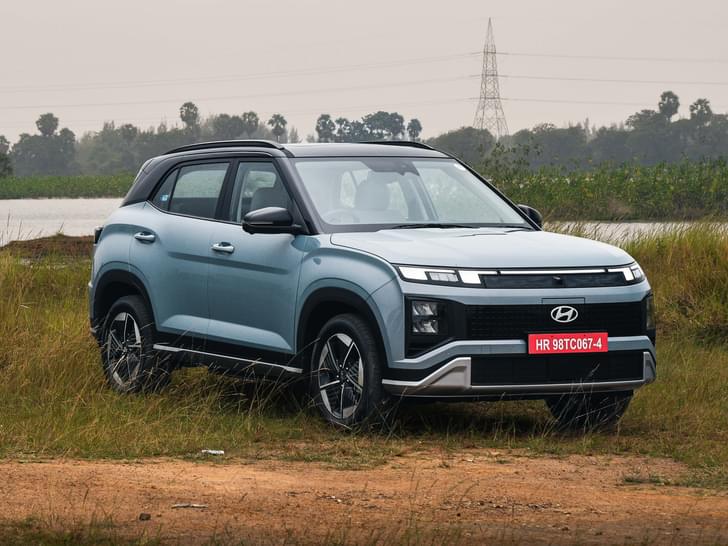The Hyundai Ai3 micro SUV, christened the Exter earlier today, will go on sale in India later this year. The upcoming Hyundai Exter marks the next step in the Korean brand’s SUV range expansion. It will be based on the Grand i10 Nios and, as such, is set to retain the hatchback’s powertrains – the 1.2-litre petrol engine with manual and AMT gearboxes, and a CNG version based on this. However, the Exter could also inherit an engine that used to be offered with the Nios, but was discontinued a little while ago – the 1.0-litre turbo petrol.
- Hyundai Exter SUV will be launched in August 2023
- Positioned between Grand i10 Nios and Venue
- Will be aimed squarely at the Tata Punch
Hyundai Exter SUV will not get a diesel engine
The platform designation of the Grand i10 Nios is ‘Ai3’, a code that denotes its longer wheelbase compared to the European i10. The new Exter micro SUV shares that designation internally, and likely the wheelbase too (as does the Aura sedan). The Hyundai Exter SUV is scheduled for launch in August this year, and Hyundai has begun teasing the vehicle recently. The Exter micro SUV will sit below the Hyundai Venue, and while Hyundai has stated that diesel is important for SUVs in India, this one will be an exception.
This is owing to its size and positioning in a segment where buyers are far more price sensitive. With ever-tightening emissions regulations, like the recently enforced BS6 Phase II or RDE norms, diesel engines have become more and more expensive. Moreover, in smaller, more city-focused cars like this, buyer preference is skewed heavily towards petrol. This is why almost no hatchback uses diesel anymore, why Hyundai discontinued its 1.2-litre diesel from the Nios and Aura last year, and why the Tata Punch never came with one.
The inclusion of Hyundai’s 1.0 T-GDi engine will give the Exter SUV an advantage over the Punch, whose sole 1.2 petrol engine is one of its few weak points. Apart from adding a bit of variety, the mid-range punch of the T-GDi engine will somewhat make up for the absence of a typically torquey diesel. It will also help set the Hyundai Exter SUV apart from its Ai3 siblings – the Nios and Aura – from which the same engine was recently discontinued.
And, although a high-tech engine that features direct injection, it’s not extremely expensive, as the 1.0 T-GDi is heavily localised for use in the i20, Venue and Kia Sonet. Hopefully, it will even use the same 120hp state of tune, and perhaps they could sell it as an N-Line model.
Hyundai Exter SUV to take on Tata Punch
The Tata Punch is the model the new Hyundai Exter SUV is squarely aimed at. Company sources tell us that having a product in this segment is a ‘no brainer’, conceding that Tata managed to steal a march on the market with the well-conceived and received Punch, which sells roughly 10,000 units a month. While there are no other direct rivals anymore, now that the Mahindra KUV100 has been discontinued, similar models vying for a piece of the Punch pie are the Maruti Suzuki Ignis and lower variants of the Nissan Magnite and Renault Kiger.
Hyundai acknowledges that hatchbacks are falling out of favour with Indian buyers, who would much rather have SUVs or SUV-looking vehicles instead, at any price point. In fact, there was no harder-hitting evidence of this for the brand than having to discontinue the second-gen Santro and the Eon before that. A strong presence in the entry segments is essential if Hyundai wants to remain India’s number two carmaker, but it has opted for this Exter budget SUV to generate volumes, rather than aiming for the budget hatchback segment again.
Will there be an SUV-styled Hyundai vehicle below the upcoming Exter micro SUV? It’s very unlikely, as Hyundai says when customers buy even a small SUV, they expect a certain amount of space. In fact, at the infancy of this very Exter SUV project, the Hyundai Casper, a Korean-market micro SUV was considered for India, but at 3.6 metres long, it was deemed too small for India, as well as too expensive. The Exter SUV that is headed to India will be around 3.8 metres long, similar to the Tata Punch, and the heavily localised Ai3 platform is cost-effective too. Early spy photos reveal it to have a boxy shape, good ground clearance and split headlamps similar to the Venue.
Would you pay more for a powerful turbo-petrol engine in a budget SUV? Let us know in the comments section below.




































